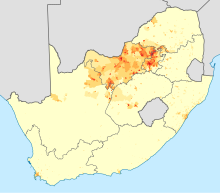Setswana
| Setswana | ||
|---|---|---|
|
Spoken in |
Botswana , South Africa , Namibia , Zimbabwe | |
| speaker | 5 million | |
| Linguistic classification |
||
| Official status | ||
| Official language in | Botswana , South Africa , Zimbabwe | |
| Recognized minority / regional language in |
Namibia | |
| Language codes | ||
| ISO 639 -1 |
tn |
|
| ISO 639 -2 |
tsn |
|
| ISO 639-3 |
tsn |
|
Setswana (also Tswana or SeTswana ) is in Botswana (90% of the population) and South Africa (9.21 percent of the population aged 15, Booth 2015) - here particularly in the province of North West - widespread and in Namibia (0.3 Percent of the population, ie about 12,000 people, have Setswana as their mother tongue ) and Zimbabwe, the local Bantu language .
History and affiliation
It is originally the language of the Batswana ethnic group . Setswana is one of the Sotho Tswana languages and is therefore closely related to Sepedi (North Sotho) and Sesotho (South Sotho). In Botswana, the language is a compulsory subject in schools.
At the beginning of the 20th century, Setswana was the first Sotho language to be written down. It was first described in 1806 by Heinrich Liechtenstein in his report on the Beetjuana language . The first books written in Setswana were the Gospel of Luke (1830), the New (1840) and later the Old Testament (1857), both translated by Robert Moffat for the London Missionary Society and printed in London in 1842 and 1872.
Setswana became the official language in South Africa in the 1990s .
Synonyms
Some outdated synonyms for Setswana are Tswana, Chuana, Sechuana, Beetjuans, Betschuanen, Coana, Cuana.
pronunciation
The letters are pronounced more or less as in German, with the exception of g , which sounds like ch in a hole , and j , which is pronounced the same as in English. The letter š is pronounced like German sch . The click sounds c , q and x as well as the letters v and z only occur in foreign words, for example from Süd-Ndebele or isiZulu .
Examples
- ke - i
- o - you / you
- o - he / she
- re - we
- le - you
- ba - she (pl.)
- Dumela - Hello
- Le kae? - How are you?
- O tsogile jang? - How are you? (formally)
- Ke teng, wena? - I'm fine and you?
- Ke tsogile sentle. I am fine. (formally)
- Tsamaya sentle - go well. (Farewell when the addressed leaves)
- Sala Sentle - Stay well. (Goodbye if you leave yourself)
- Ke itumetse - Thank you (formal)
- Ke a leboga - thank you (colloquial)
- Tswee tswee - please
- ee - yes
- nnyaa - no
- Ke lapile. - I am tired.
- Boroko. - Good night
- Robala sentle. - Sleep well.
- Ditoro tse months. - Sweet Dreams.
- O robetse ak? - How did you sleep?
- O robetse kae? - Where did you sleep?
- O kae? - Where are you?
- Ke go tlhologeletse. - I miss you.
- Ke rata ... - I like ...
- Ke a go rata - I love you.
- O batla tight? - What would you like?
- Ke batla metsi. - I would like water.
- Ke bo kae? - How much is it?
- Leina la gago ke mang? - What is your name?
- Leina la me ke ... - my name is ...
- O tswa kae? - Where are you from?
- Ke tswa kwa Germany. - I'm from Germany.
- Ke nyorilwe. - I'm thirsty.
- Ke tshwere ke tlala. - I'm hungry.
- Ke itumetse. - I am happy.
- A o bua Setswana? - Do you speak Setswana?
- Ke bua Setswana ga nyane. - I speak a little about Setswana.
Web links
- Tswana at ethnologue.com (English)
- Language tips at www.botswana-tourism.gov.bw (English / Setswana)
Individual evidence
- ↑ a b tsn
- ^ Institute of Race Relations : South Africa Survey 2017 . Johannesburg 2017, p. 74
- ↑ Ype Schaaf: L'histoire et le rôle de la Bible en Afrique , CETA, HAHO et CLE, Lavigny 2000, ISBN 9-966-886-72-9 , pp. 88-92


